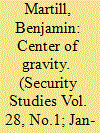|
|
|
Sort Order |
|
|
|
Items / Page
|
|
|
|
|
|
|
| Srl | Item |
| 1 |
ID:
164068


|
|
|
|
|
| Summary/Abstract |
Cold War strategy in Western Europe almost exclusively followed the US policy of containment. Conventional explanations for this continuity, however, fail to account for both the strategic rationale and the scale of domestic support behind attempts to disengage from the Cold War. This article seeks to explain why containment won out over disengagement in European strategy. By highlighting the underlying liberal tenets of containment, it argues this victory owed more to the advantages afforded the political center by the political institutions of Western Europe than to the logic of containment strategy itself. The occupation of the center-ground by advocates of containment afforded them distinct institutional advantages, including an increased likelihood of representation in government, greater bargaining strength relative to other parties, and limited sources of viable opposition. The dependence of containment strategy on centrist strength is demonstrated through a discussion of the politics of strategy in the French Fourth Republic.
|
|
|
|
|
|
|
|
|
|
|
|
|
|
|
|
| 2 |
ID:
164067


|
|
|
|
|
| Summary/Abstract |
Living with a nuclear-armed enemy is unattractive, but, strangely, states seldom use their military power to prevent the enemy’s entry into the nuclear club. It is puzzling why preventive strikes against nuclear programs have been quite rare. I address this puzzle by considering the role of conventional retaliation, a subfield of deterrence that so far has received scant attention in the literature. I theorize the concept of conventional retaliation and test its explanatory power. First, I explore all historical cases where states struck another state’s nuclear installations and find none occurring when the proliferator threatened conventional retaliation. Second, I explore two cases where a strike was most likely, but the would-be attacker balked and find smoking-gun evidence that the threat of conventional retaliation restrained the would-be attacker. This evidence supports my claim that the threat of conventional retaliation is sufficient to deter a preventive strike against emerging nuclear states.
|
|
|
|
|
|
|
|
|
|
|
|
|
|
|
|
| 3 |
ID:
164069


|
|
|
|
|
| Summary/Abstract |
This article argues that militant clients should be understood as a pillar of Iran's grand strategy and an extension of its military power. The article examines why Iran has relied on militant clients since the 1979 revolution and the benefits and costs of its client approach. In evaluating these issues, it identifies five main areas where Iran has gained from its client strategy: 1) maintaining independence from the West; 2) successfully exporting its religio-political worldview; 3) extending its military reach and power; 4) reducing political costs of its foreign activities; and 5) establishing needed regional allies. It further identifies five main dangers that Iran faces by continuing its strategic behavior: 1) increased pressure from the United States and a broader US military regional footprint; 2) more unified regional adversaries; 3) the risk of unintended escalation with the United States and regional adversarial states; and 4) enduring regional instability and insecurity
|
|
|
|
|
|
|
|
|
|
|
|
|
|
|
|
| 4 |
ID:
164065


|
|
|
|
|
| Summary/Abstract |
Scholars from numerous disciplines continue to study, debate, and value Thucydides’ The Peloponnesian War. This review essay first explores and elaborates many of the enduring and vital contributions of Thucydides for IR theory. It then assesses and engages three new books, including a major, wide-ranging collection of new essays and a very influential (and deeply flawed) attempt to apply the lessons of that work—one that warns of a “Thucydides Trap” that might unwittingly ensnare the United States and China, resulting in an unwanted and catastrophic war between the two. This review essay argues that, as illustrated by the books under consideration here, contemporary IR scholars would be very well served by taking Thucydides seriously and would benefit from reading and considering his History with great care; at the same time, there are enormous, perilous analytical dangers inherent in attempting to draw conclusions from a superficial reading of The Peloponnesian War.
|
|
|
|
|
|
|
|
|
|
|
|
|
|
|
|
| 5 |
ID:
164066


|
|
|
|
|
| Summary/Abstract |
What strategic logics underlie terrorist groups’ use of linked suicide attacks? Are the goals that groups seek to achieve when sending linked bombing teams somehow inherently different than when sending individual suicide bombers? To answer these questions, this article introduces three typologies of linked suicide bomber detonation profiles—simultaneous, sequential, and nonproximate—and theorizes why terrorist groups might view each type of linked suicide bombing to be preferable to deploying a single suicide bomber. Improvements resulting from using an individual attacker include: ensuring a higher likelihood of successfully hitting a given target (simultaneous detonations); causing more casualties than a single bombing (sequential-wave detonations); and engendering wider-spread shock and awe (nonproximate detonations). Drawing on an original dataset detailing the entirety of Boko Haram’s suicide bombing efforts from 2011 to 2017, we then examine the extent to which these linked bombing typologies do actually appear to successfully lead to an improvement over the deployment of single suicide bombers. While we find that sequential-wave and nonproximate suicide bombings demonstrate evidence of hypothesized improvements over the deployment of single suicide bombers, our data show that deploying simultaneous suicide attackers does not lead to higher efficacy at targeting when compared to the deployment of individual bombers. In attempting to account for this fact, we argue that Boko Haram’s simultaneous detonation teams likely fail to show an improvement over single-bomber attacks because they tend to be composed of what we call “unenthusiastic and under-trained” bombers: teams of often uncommitted women, and sometimes children, which it deploys in tandem in a bid to avoid individual defection and increase the likelihood of at least one detonation in an attack. We conclude by suggesting what the process of linked bombing reveals about both terrorist groups in general and Boko Haram specifically.
|
|
|
|
|
|
|
|
|
|
|
|
|
|
|
|
|
|
|
|
|